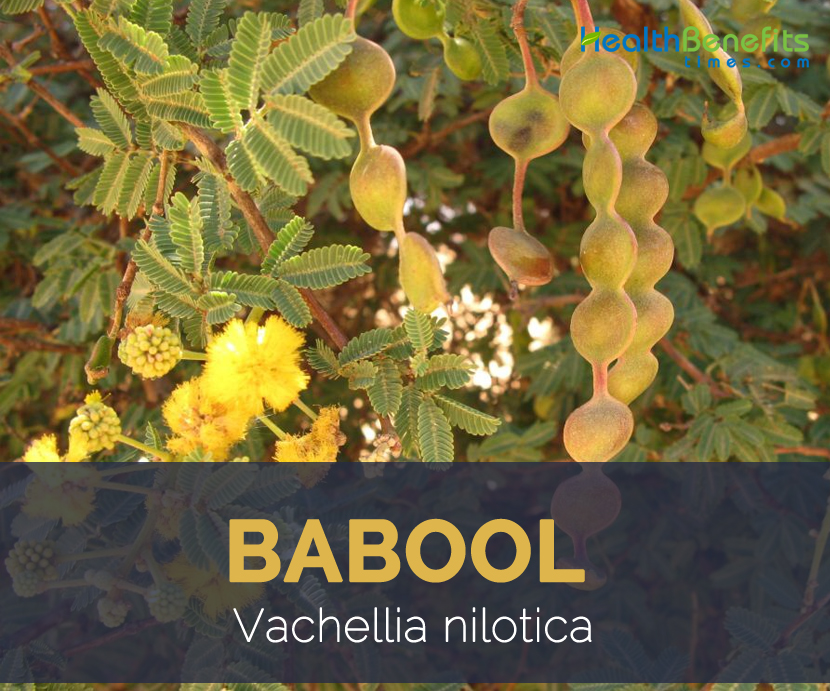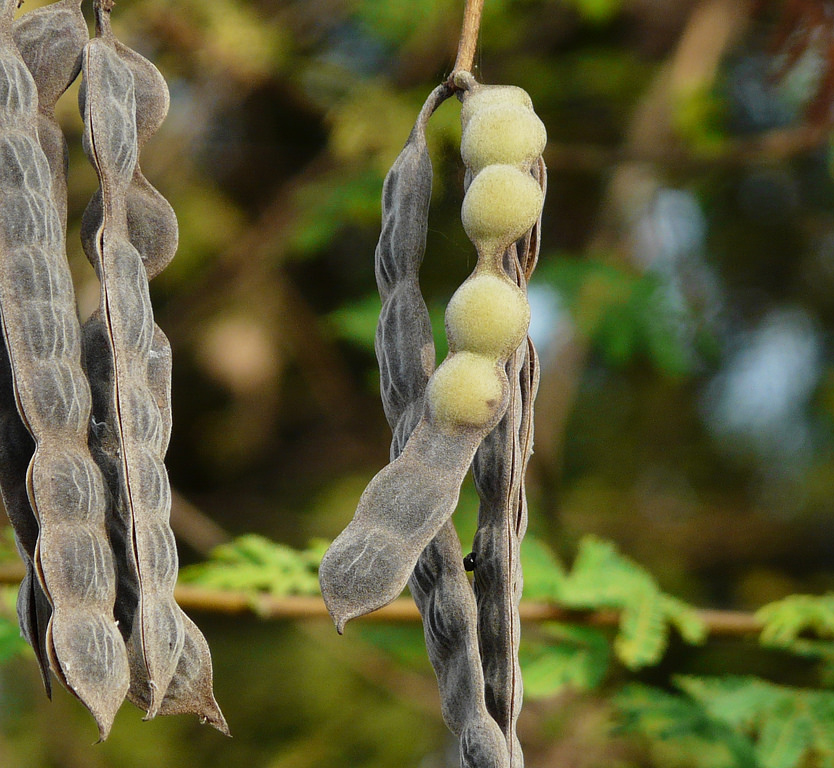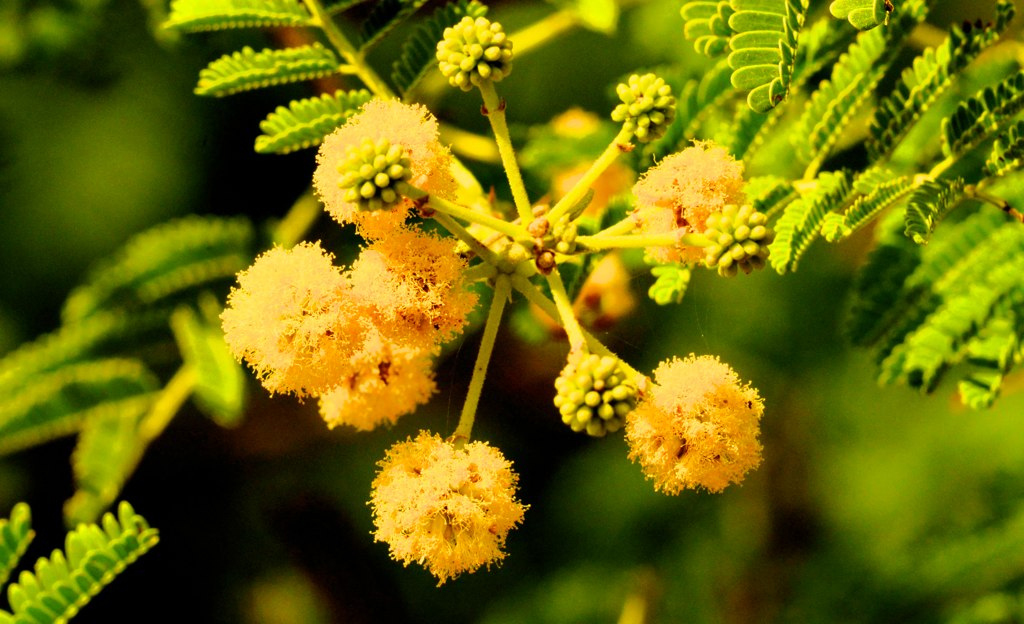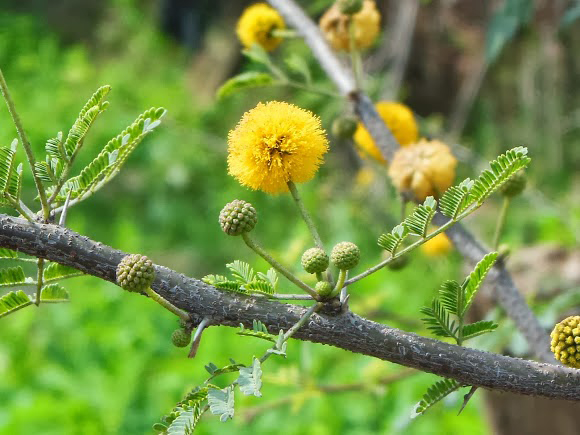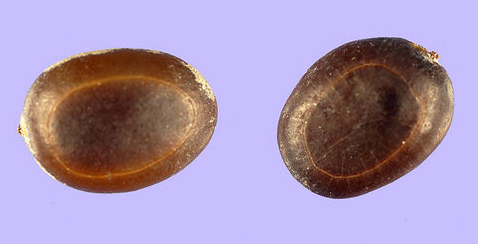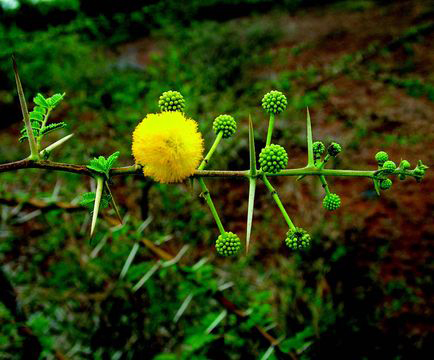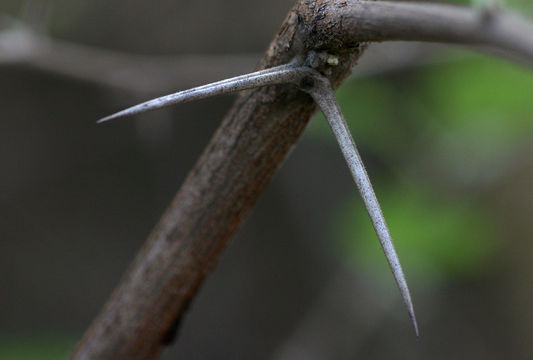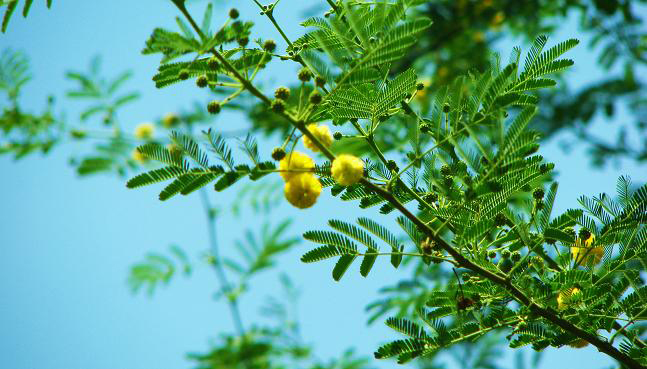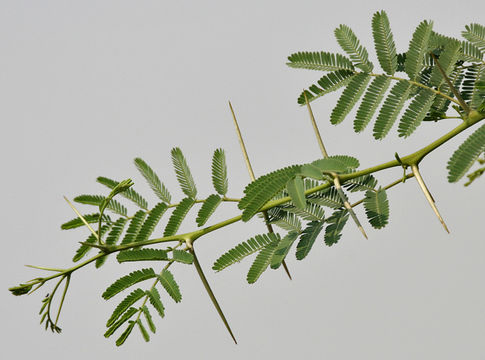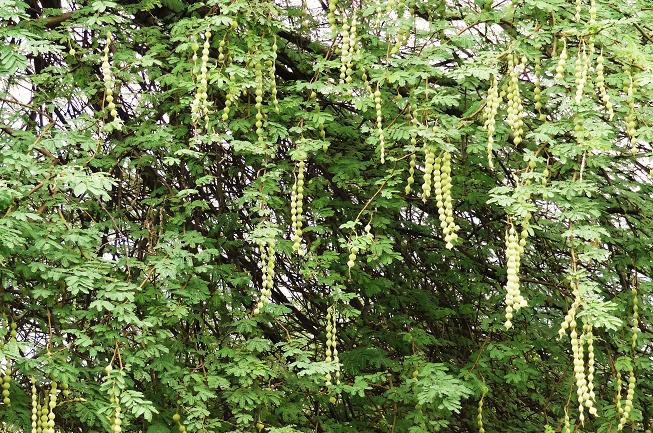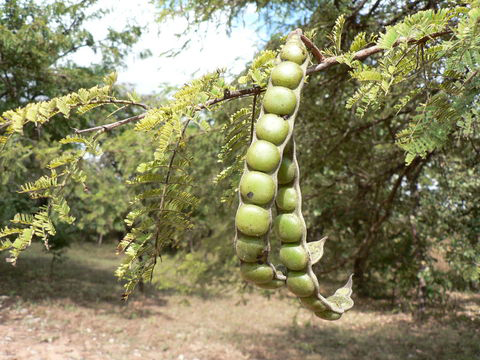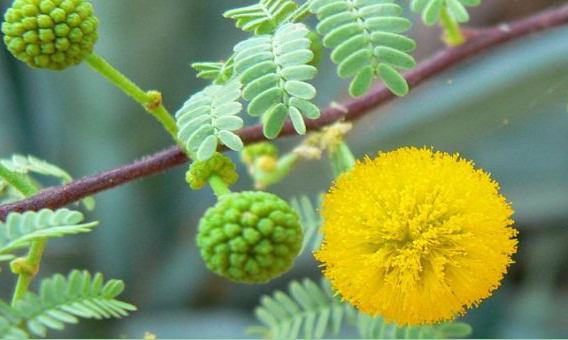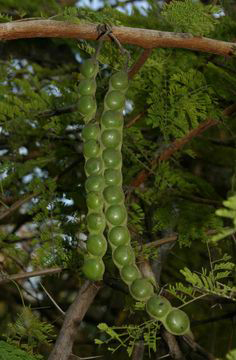Description
Overview: Babool is a large spreading multi-stemmed shrub or small upright (i.e. erect) single-stemmed tree about 7 to 13 meter tall, with a stem diameter of 20 to 30 cm. It prefers semi-arid, warmer temperate and sub-tropical regions but is also found in tropical environments and will grow near water sources in arid areas. It grows well in alluvial loam and black cotton soils. Plant has deep woody taproot with several branching surface laterals. The crown is low, spreading and almost symmetrical, and can be flattened or a rounded umbrella-shape (in free standing specimens). The bark is very dark brown to black with deep regular vertical grooves in older specimens. The thorns are almost straight, paired at the nodes of the stem and usually pointing slightly backwards.
Stems
Stems are whitish and either hairy or occasionally hairless when young and turn a darker color (i.e. grey to brown) as they age and become woody. They are usually covered in tiny whitish-colored raised spots (i.e. lenticels). The trunks of mature trees are rough with fissured bark towards their base that is brown, reddish-brown or black in color. Pairs of stout greyish-colored spines (2-50 mm long, occasionally up to 10 cm in length) are borne at the base of each leaf (i.e. near the leaf axils). Sometimes these spines may be inconspicuous (i.e. they may occasionally appear to be absent from some branches), and they are usually absent from the trunks and older branches.
Leaves
Leaves are twice-compound (i.e. bipinnate) and are dark green in color and have a feathery appearance. They are borne on a relatively short leaf stalk (i.e. petiole) 4-20 mm long, which is finely hairy and sometimes has a small raised structure (i.e. gland) just below the lowest pair of leaf branchlets (i.e. pinnae). The extension of the leaf stalk (i.e. rachis) is 8-68 mm long and bears 2-10 pairs of small leaf branchlets (i.e. pinnae). A small raised gland is usually present on the rachis, at the junction of the uppermost one or two pairs of leaf branchlets (i.e. pinnae). Each of the leaf branchlets (1-5 cm long) bears numerous (7-30) pairs of small, oblong or narrowly oblong leaflets (i.e. pinnules). These leaflets (2-7 mm long and 0.5-2 mm wide) are usually hairless (i.e. glabrous), but sometimes have somewhat hairy (i.e. ciliate) margins, and have rounded tips.
Flowers
Flowers are small yellow or golden-yellow colored and are densely arranged into small globular clusters (6-15 mm across). Each individual flower has four or five relatively inconspicuous petals and sepals and numerous conspicuous stamens that give the flower clusters a very fluffy appearance. The globular flower clusters contain 30-50 of these flowers and are borne on hairy stalks (i.e. peduncles). These stalks (7-32 mm long) originate from the leaf forks and usually have some tiny bracts about half way along them. The flower clusters are borne in groups of two to six in each leaf fork (i.e. axil). Flowering occurs throughout the year, but is most abundant during autumn and winter (i.e. from March to July).
Fruits
The fruit is an elongated pod which is 6-25 cm long and 4-17 mm wide and is swollen around each seed and strongly constricted between the seeds, and thus resembles a string of pearls. These greyish-green pods are covered in tiny soft hairs, are somewhat flattened, and turn green to brown in color when mature. However, very old pods may turn dark brown or black in color after being shed from the plant. They contain about 8-15 seeds, do not split open at maturity (i.e. they are indehiscent), and are most commonly present during late winter, spring and summer (i.e. from May to January). The brown or blackish-brown colored seeds (6-7 mm long and 4.5-6.5 mm wide) are sub-globular in shape and somewhat flattened. They are smooth in texture and have a hard seed coat.
History
Vachellia nilotica has been used since early Egyptian dynasties. Disocorides (the Greek philosopher, physician and ‘father of botany’ c.40 to 90 A.D.) described in his Materia Medica a preparation extracted from the leaves and fruit pods. He called this ‘akakia’, and it is from this word that the modern name is derived. The origin of the previous name for the genus was Acacia which means ‘spiny’ and is a typical feature of the species. Today it is grown throughout the world because of its wonderful health benefits.
Nutritional Value
Apart from their wonderful benefits, babool is a good source of nutrients, vitamins and minerals. Using 100 gram of babool offers 4.28 mg of Iron, 0.902 mg of Manganese, 13.92 g of Protein, 6.63 g of Total Fat and 0.256 mg of Zinc. Moreover many Amino acids 5 g of Valine, 2.63 g of Histidine, 3.06 g of Isoleucine, 3.2 g of Threonine, 4.98 g of Lysine and 3.06 g of Leucine are also found in 100 gram of Babool.
Health Benefits of Babool
Leaves, bark, pods and gum of babool tree have medicinal virtues. The pods help remove catarrhal matter and phlegm from the bronchial tubes. The gum calms any, irritation of the skin and soothes the inflamed membranes of the pharynx, alimentary canal and genito-urinary organs. Listed below are some of the popular health benefits of using babool for health
1. Diarrhea
Various parts of babool tree are useful in diarrhea of ordinary strength. A mixture of equal parts of the tender leaves with white and black cumin seeds (zeera) can be administered in doses of 12 grams, thrice daily. An infusion made of the bark of the tree may also be taken thrice daily for the same purpose. The gum used either in decoction or in syrup, is an effective medicine for diarrhea.
2. Heals Wounds
Babool leaves are quite beneficial for healing wounds. The leaves and bark of the babool have the ability to control the bleeding and infection thus healing the wounds, cuts and injuries.
3. Controls hair fall
Babool leaves are quite beneficial for the health of hair. To control hair fall, apply the paste of babool leaves on scalp. Wash the hair after 30 minutes with a good quality shampoo for best results. Always use warm water to wash your hair.
4. Teeth Disorders
Chewing of fresh bark of this tree daily, helps to strengthen loose teeth and arrest any bleeding from the gums. Dirty teeth can be cleaned efficiently by brushing them with a powder in which 60 grams of charcoal of babool wood, 24 grams of roasted alum and 12 grams of rock salt have been included.
5. Eczema
Bark of babool tree is useful in the treatment of eczema. About 25 grams each of this bark and the mango bark should be boiled in about 1 liter of water and the vapors allowed fomenting the affected part. After the fomentation, the affected part should be massaged with ghee.
6. Tonsillitis
Babool tree is extremely beneficial for dealing with tonsillitis. A decoction of the bark, mixed with rock salt can be used as a gargle in treating tonsillitis.
7. Skin treatment
Babool leaves and bark are beneficial in getting rid of itching and dryness. Dry skin is a big problem during winter months. By applying the paste of babool leaves to the itching area, you can get relief. Due to its anti-inflammatory properties, babool leaves are good for treating various other skin related problems too.
Apart from that Babool plant is also beneficial for maintaining a young look. It nourishes skin and gives it a shiny appearance. It is used by cosmetic companies to make astringents and skin cleaners. You can also dip the leaves of babool in your bath water for a refreshing bath.
8. Conjunctivitis
Leaves of babool tree are effective in the treatment of conjunctivitis. The leaves, ground to a paste, should be applied on the affected eyes at night, supported by a bandage which should be untied the next morning. This removes pain and redness.
9. Epiphora
Leaves of babool tree are beneficial in treating epiphora that is watering of the eyes, in which tears flow onto the cheeks due to abnormality of the tear drainage system. About 250 grams of leaves should be boiled in one and a quarter liter of water until only a quarter liter of water is left. This should then be filtered and kept in a well-corked bottle. The eye-lids should be painted morning and evening with this liquid.
10. Leucorrhoea
Bark of the babool tree is useful in leucorrhoea. Its decoction should be used as a vaginal douche for treating this disorder.
11. Spermatorrhoea
Fresh pods of babool tree are effective in sexual disorders like spermatorrhoea, frequent night discharges, loss of viscidity of the semen and premature ejaculation. In Ayurveda, a preparation made from the pods is considered highly beneficial in treating these disorders. It is prepared thus: about 1 to 1.5 meters of coarse cloth is spread evenly and its corners secured. The fresh pods of babool tree -are pounded and their juice squeezed. This fresh juice is pasted on the cloth every morning and evening for at least 20 days until a 5-6 centimeters thick layer is formed on it. A small piece of this cloth weighing 5 to 9 grams is cut and boiled in a liter of cow’s milk which is taken after adding brown sugar to taste.
It is also said to increase the power of retention of the semen. Even extremely debilitated patients suffering from the bad consequences of masturbation are believed to get rejuvenated by its use and attain normal retentive power. It improves the viscidity of the semen and is an excellent medicine for spermatorrhoea.
Ayurvedic Health Benefits of Babool
- Eye pain: Grind the soft tender leaves and put 1-2 drops of the extract, in the eyes. It treats swelling of the eyes and eye pain.
- Toothache:
- Burn the peel of its pod and almonds. Brush your teeth using the ash. It treats toothache effectively.
- Use the soft branches to brush the teeth. It strengthens the teeth and cures all types of tooth infections.
- Jaundice: Mix equal quantities of its flower powder with sugar candy. Give 10 gm. of this powder to the patient, thrice a day. It fastens the recovery of jaundice.
- Diarrhea: Take 8-10 leaves of babool and grind them with small amounts of roasted cumin seeds. Give 10 gm. of this mixture orally at night. It cures diarrhea.
- Stomach related problems: Prepare a decoction of its inner bark and give 1-2 gm. of this with buttermilk. It cures all types of abdominal disorders.
- Throat problems: Take equal quantities of its leaves, bark and bark of babool tree. Soak them in a glass of water. Use this solution to gargle. It cures throat problems.
- Eczema: Grind the flowers of acacia tree, in vinegar and make a paste of it. Apply this on affected areas. It is very effective in curing eczema.
- Pregnancy:
- Give 2-4 gm. powder of its leaves, every morning. It helps in conceiving.
- During pregnancy, it should be given to the woman. It improves the physical strength.
- Reduce Excessive sweating: Grind equal quantities of its leaves and young harad. Massage the body with this powder and after sometime, take a bath. Regular use of this controls the sweat.
- Helpful in Lumbago: Take equal quantities of its bark, pod and gum. Grind them all to form a powder. Give one teaspoonful of this powder, thrice a day. It gives relief from the pain in the waist.
- Metrorrhagia: Take equal quantities of babool’s gum and wheat. Grind them and take 2 teaspoonful of this powder, every morning and evening. It controls excessive bleeding during menstrual cycle.
- Sexual disorders: Shade dry the pods and grinds them. Mix them with equal quantity of sugar candy. Give 1 teaspoon of this powder, every morning and evening, with fresh water. It thickens the semen and cures all problems related to sexual organs and functioning.
- Wounds: Take few tender leaves of Babool and powder it and Sprinkle, this powder on the wounds, to get quick healing.
- Fractures: To fasten healing of fractures, take the powder of the fruits of Babool, mix it with honey and take this for three days consequently.
- Complexion of baby: Chewing babool leaves during pregnancy allows a woman to deliver a baby with a clear, glowing complexion.
- Skin disorders: Just like Khedira, the decoction of Babool bark is also highly useful as a drink, bath water and to wash lessons. It alleviates burning sensation, restores normal color to skin and heals ulcers and wounds quickly.
- Loss of Appetite: Prepare pickle of its soft pods mixed with rock salt. It improves the taste.
- Mucous Diarrhea: Take 7-9 leaves and grind them with small amounts of cumin seeds and roasted cumin seeds. Give 5gm of this mixture orally at night.
- Blood Dysentery & Diarrhea: Take 1 teaspoon juice of its leaves and give to the patient with honey, 1-2 times a day.
- Ulcer/ Wound: Paste of its leaves heals the wounds. It also cures swelling due to heat.
Other Traditional uses and benefits of Babool
- It helps in reducing the swelling of the uterus.
- Stem, bark and the pods act against the intestinal worms and help in coagulation of the blood.
- Paste of the bark of the plant is applied over oozing eczemas.
- Powder of the dried leaves is spread over fresh wounds to control bleeding.
- In case of rectal prolapse, the patient is recommended sitz bath over the decoction prepared from the bark of the Indian Babool plant.
- Decoction prepared from the bark of the plant is used for gargling in the diseases of mouth ulcer and bleeding gums.
- Paste from the leaves of the plant is applied over wound and injury caused due to contact with fire.
- Decoction of the plant is given in a dosage of 40-50 ml to treat diarrhea and to treat intestinal worms.
- Decoction prepared from the pods of the plant Babool is used to treat excessive bleeding during menstruation.
- Decoction of the pods and bark, in a dosage of 45-50 ml is given to treat bleeding piles and hemorrhoids.
- Leaves are crushed and consumed along with a teaspoon of sugar, once or two times a day, for the treatment of spermatorrhoea.
- It is used for stomach upset and pain.
- Bark is chewed to protect against scurvy.
Other Facts
- In India branches are commonly lopped for fodder.
- Pods are best fed dry as a supplement, not as a green fodder.
- Tender twig of this plant is used as a toothbrush in south-east Africa and India.
- It makes a good protective hedge because of its thorns.
- The tree’s wood is “very durable if water-seasoned” and its uses include tool handles and lumber for boats.
- Wood of Vachellia nilotica was used by ancient Egyptians to make statues and furniture.
- Pods are desirable as fodder for cattle, and the leaves, young shoots and young pods are thought to aid milk production.
- Vachellia nilotica wood burns without too much smoke and provides good charcoal.
- Flowers provide pollen and nectar for bees.
- It is suitable for live fencing, mine timber, railway sleepers, boat building, wheels, and water wells as its wood is durable and resistant to borers and termites.
- Sap-wood and heart-wood was used in ancient Egypt for house beams, furniture, panelling and statues as it was regarded as impervious to insect and fungus attack.
- Bark contains tannins and has been used to preserve and soften leather.
Babool Facts
A thorny tree, Babool shoots up to a height to 12 meters and flaunts small yellow round nectar- less flowers. One can spot this gum Arabic tree by its red brown to blackish rough bark, and fern like leaves. It is widely seen in Arabia and West Asia. It is known for its gum, which is made from the hardened sap taken from the tree. The tree is planted for its bark, which yields the babool gum. This gum has several other uses apart from being used for the treatment of injuries and for therapeutic purposes. Babool trees can flourish in dry and arid regions. Babool trees find use in households as well as in farms and fields for shelter and foraging purposes.
| Babool Quick Facts | |
|---|---|
| Name: | Babool |
| Scientific Name: | Vachellia nilotica |
| Origin | Africa, the Middle East and the Indian subcontinent |
| Colors | Green when young, turning black when ripe |
| Shapes | Softly hairy flattened pod 6 to 25 cm long, 1 to1.5 cm wide, strongly constricted between each seed; pods slightly sticky internally |
| Major nutrients | Valine (236.74%) Histidine (213.47%) Isoleucine (183.01%) Threonine (181.82%) Lysine (148.92%) |
| Health benefits | Diarrhea, Heals Wounds, Controls hair fall, Teeth Disorders, Eczema , Tonsillitis, Skin treatment, Conjunctivitis, Epiphora, Leucorrhoea,Spermatorrhoea |
| Name | Babool |
|---|---|
| Scientific Name | Vachellia nilotica |
| Native | Africa, the Middle East and the Indian subcontinent |
| Common Names | Gum arabic tree, Babul/Kikar, Egyptian thorn, Sant tree, Al-sant or prickly acacia, thorn mimosa or prickly acacia, lekkerruikpeul or scented thorn, karuvela maram ,algaroba, babul acacia, black thorn, blackthorn, Egyptian acacia, gum arabic tree, gum-arabic tree, Indian gum-arabic tree, Nile acacia, prickly mimosa, scented pod acacia, thorny acacia, thorn-mimosa |
| Name in Other Languages | English: Acacia, Black Piquant, Cassie, Cassie á Piquants Blancs, Egyptian Mimosa, Egyptian Thorn, gum arabic tree, Motse, scented-pod acacia, Scented-thorn, Wattle (East Africa), babul acacia, black babul, Egyptian acacia, Indian gum-arabic-tree, Nile acacia, prickly acacia, thorn-mimosa, thorny acacia Afrikaans: Lekkeruikpeul Arabic: Aqaqia eisarat thamar (أقاقيا عصارة ثمار ) Aqaqia asara thmar, akasiaa alnnayl ( أكاسيا النيل), Akasia alnil, alssamgh alearabi (الصمغ اعربي) Al samgh al’ arabi (gum), shawakkat misria (شوكة مصرية) Shoka msiria, Sunt arbi, sunt alnnayl( سنط النيل) Sunt alnil, alssint alearabi (السنط العربي), alssint alnnayli (السنط النيلي) Assamese: Babala Bambara: Barana Chinese: Cì héhuān( 刺合欢), Ālābó jiāo shù (阿拉伯胶树), Ālābó jīn héhuān (阿拉伯金合欢), Jiāo shù (膠樹), Ālābó shùjiāo (阿拉伯樹膠), A la bo jin he huan (阿拉 伯 金合欢) Czech: Akácie arabská, Akácie nilská Danish: Gummiakacie, Egyptisk akacie Dutch: Babul, Echte acacia, Gom-acacia. Estonian: Araabia akaatsia, Niiluse akaatsia. Finnish: Niilinakasia, Babulakaasia French: Acacia à gomme, Gommier rouge, Gonakier, Acacia du Nil, Acacia du Sénégal, Acacia nilotique German: Ägyptische Akazie, Ägyptischer Schotendorn, Arabische Gummiakazie, Arabischer Gummibaum. Greek: Akakia i arabiki. Gujrati: Bāvaḷa Baval (બાવળ Baval), Bāvaḷiyō (બાવળિયો) Bavaliyo, Babaria, Baval, Kaloabaval Hausa: Bagaruwa, Bararuwa, Marjee, Namijin bagaruwa. Fulah: Gaude, Goondi Hindi: Babla, Babul, Babula, Babuul (babūl) (बबूल), Babur (bābur)( बबूर) , Banwal, काला कीकर (kālā kīkar), खैर Khair, कीकर Kikar (kīkar), Vabbla, Vabboola, बनवाल, बबूल Hungarian: Egyiptomi akácia , Nemes acacia Italian: Acacia Arabica Japanese: Arabia akashia(アラビアアカシア) , Arabia gomu modoki (アラビアゴムモドキ) Kannada: Babbuli, Baunijali, Bobbuli, Karijali (ಕರಿಜಾಲಿ) , Ramakanti . Latin: Succus acacia, Mandinka: Bano Malayalam: Babola, Babul, Kalababli, Karivelam (karivēlam)( കരിവേലം), Karuvelakam, Karuvelam, Karuvelum, Veluthakaruvelan Marathi: Bābhūḷa (बाभूळ) Babhul Oriya: Babula, Bambuda, Baubra Portuguese: Acácia-egípcia. Punjabi: Kikkar. Russian: Akatsiia nilotika (Акация нилотика), Akatsiia nil’skaia (Акация нильская), Akatsiia arabiiskaia (Акация аравийская), Araviyskuyu kamed’ (Аравийскую камедь) (Gum), Gummiarabik (Гуммиарабик) (Gum). Sanskrit: Barbar, Deerg hakantaka, Ajameghya, Babur, बब्बूलः Babbula (babbūla), Barburah, Bavari, Khadir (खदिर), Karuvelum, Koudia babul, वर्वू Varvu, वर्वूर Varvur, Vavari. Sereer: Neeb neeb, nef Shona: Mubayamhondoro, Muhunga, Muzunga Sinhalese: Baabulu (as A. arabica), Katu kihiri. Somali: Guider Spanish: Acacia espinosa, acacia gomifera, Acacia arábiga, Acacia de Egipto, Espino egipcio Swahili: Mgungu Swedish: Bablah, Gummiakacia. Tamil: Karuvelam, Karuve (karuvē), Karuvel, Karu velum, Karuvelai (கறுவேளை) , Karuvelampicin, Karuvelampisin, Karuvelan . Wolof: Neb neb Telugu: Baburram, Nakka Dumma, Barbaramu, Nallatumma (నల్లతుమ్మ), Thumma chettu, Tumma, Tumma bamka, Tumma jiguru ceTTu. Bengali: Bawala, Keekar, Babala (বাবলা), Babla (bāblā), Babul Kannada: Jaali Mara Urdu: (Babul) ببول , Babur (ببور) , Gond babul, Gond kikar, Gond kikar saida, Khadir(کهدر), Phali kikar, Samagh arab saida. Unani: Aqaaqia, Babuul, Kikar,Mughilaan, Samur Siddha: Karu-velamaram, Karuvelei, Velampisin UnIdentified: Fantsikasia (Madagascar), Subyu. |
| Plant Growth Habit | Large spreading multi-stemmed shrub or small upright (i.e. erect) single-stemmed tree |
| Growing Climate | Prefers semi-arid, warmer temperate and sub-tropical regions but is also found in tropical environments and will grow near water sources in arid areas. |
| Soil | Alluvial loam and black cotton soils. |
| Plant Size | 7 to 13 m tall |
| Root | Deep woody taproot with several branching surface laterals |
| Stem | Whitish and pubescent when young becoming darker with age; woody; to 7 m long, branching almost from the base and stem diameter of 20 to 30 cm |
| Bark | Very dark brown to black with deep regular vertical grooves |
| Branches | Round, soft and bent ones. New tender branches are slippery and oily. |
| Leaf | Bipinnate, 4.5 to 7 cm long, with 2 to 14 pairs of pinnae. The leaflets are 1.5 to 7 mm long. |
| Flower | Bright yellow and borne on globe-shaped flower heads. The flowers are sweetly scented and appear near the beginning of the rainy season |
| Fruit Shape & Size | Softly hairy flattened pod 6 to 25 cm long, 1 to1.5 cm wide, strongly constricted between each seed; pods slightly sticky internally |
| Fruit Color | Green when young, turning black when ripe |
| Seed | Depressed, subglobular |
| Plant Parts Used | Stem bark, fruit, gum, seeds, Leaves, Root, Pods, resin and wood |
| Major Nutritions | Valine 5 g (236.74%) Histidine 2.63 g (213.47%) Isoleucine 3.06 g (183.01%) Threonine 3.2 g (181.82%) Lysine 4.98 g (148.92%) Leucine 3.06 g (82.79%) Iron, Fe 4.28 mg (53.50%) Manganese, Mn 0.902 mg (39.22%) Protein 13.92 g (27.84%) Total Fat (lipid) 6.63 g (18.94%) |
| Health benefits |
|
| Traditional Medicinal Uses |
|
| How to Eat |
|
| Other Facts |
|
| Precautions |
References:
http://davesgarden.com/guides/pf/go/185758/
http://www.hear.org/pier/species/acacia_nilotica.htm
https://en.wikipedia.org/wiki/Vachellia_nilotica
http://www.theayurveda.org/ayurveda/herbs/12-medicinal-benefits-acacia-tree-babool-tree/
http://easyayurveda.com/2016/05/20/babool-tree-acacia-nilotica-acacia-arabica/
http://archive.allayurveda.com/babul-herb.asp
http://www.gbif.org/species/108497175/synonyms
http://www.plantnames.unimelb.edu.au/Sorting/Acacia.html
https://www.itis.gov/servlet/SingleRpt/SingleRpt?search_topic=TSN&search_value=819931#null
http://powo.science.kew.org/taxon/urn:lsid:ipni.org:names:77089275-1
http://www.fao.org/ag/agp/agpc/doc/gbase/data/pf000124.htm
https://keyserver.lucidcentral.org/weeds/data/media/Html/vachellia_nilotica.htm
https://www.bimbima.com/ayurveda/medicinal-use-of-babul-tree/1149/
http://www.feedipedia.org/node/346


